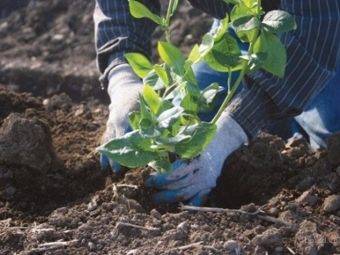Blueberry "Bluegold": characteristics of the berries and recommendations for growing

Blueberry is a plant that is capable of not only pleasing the eye with various shades of blue, but also has many beneficial properties.Despite its relative "youth" in Russian gardening, interest in a beautiful berry increases with each season. "Bluegold" - is one of the most popular varieties of blueberries, which is well acclimatized in almost any garden, refreshing and adding color to the exterior.
Variety description
The real birthplace of blueberries is North America. The natural habitat of a culture is the wetlands where it grows broadly and abundantly. However, a series of successful experiments in the domestication of berries led to the fact that now blueberries can be grown in any climate. "Bluegold" is one of the young hybrids, bred in 1989. From the English language, this name translates as “blue / blue gold”, which can not but arouse interest and curiosity among gardeners.
"Bluegold" is a tall blueberry, which belongs to the early varieties, so the coloring of berries begins in early June. The fruits ripen fairly quickly and by the middle of summer they are fully prepared for harvest. Ripe blueberries have a light blue color and are smooth to the touch. The taste of the fruit is sweet, with a slight admixture of sourness. As a rule, each bush gives a rich harvest, from 4 to 6 kilograms of berries.
Blueberry "Blyugold" has a number of indisputable advantages over other varieties. Due to the high density of berries, they can be not only easy to collect, but also fearlessly transported. Shrubs are not afraid of frost, they will not die at temperatures as low as –35 degrees, and the frozen blueberry fruits will not lose their beneficial properties.
It is also worth noting the high yield of bushes - with good care, they will bear fruit for at least 50 years, bringing several kilograms of berries. Blueberry and pollination are not required, since the plant is consistently “self-replicating” from year to year.
Along with the advantages, the Bluegold variety has its drawbacks. Shrubs grow rapidly, entangling nearby plants, so it is important to remember about timely trimming of extra twigs. As well as berries, they tend to dry and crumble in dry and hot weather.
The harvest of this variety is recommended to be collected immediately after ripening, otherwise most of it may disappear.
Beneficial features
It is difficult to overestimate the healthy properties of blueberries, because it not only heals, but also helps prevent many serious diseases. Scientists say that the berries of the miraculous plant strengthen the nervous system, prevent aging of the body, improve blood flow and vascular walls. Regular consumption of fruits has a good effect on vision and memory, increases concentration. Blueberries will be especially useful for those who have problems with the cardiovascular system, because the berries lower the pressure and strengthen the arteries.
Like most varieties, Bluegold is a huge storehouse of vitamins and minerals. Eating a few servings of berries a day, you can not worry about buying a vitamin complexbecause blueberries contain almost all the elements necessary for the body. In addition, the beneficial fruits are suitable for people suffering from diabetes and overweight. Berries will help reduce blood sugar and normalize metabolism. And folic acid, which is also in blueberries, will be a good alternative to tablets for expectant mothers.
Very good reviews leave gardeners not only about fresh, but also about frozen blueberries. Of course, having a lot of bushes and a bountiful harvest of several tens of kilograms, it will be simply impossible to eat it fresh.
Do not be afraid that when frozen, the berry will lose its useful qualities. Bluegold retains all its vitamins and minerals when it is frozen. However, berries are not recommended to store more than six months. It is much more profitable to use them when cooking jam, stewed fruit, as well as for baking and decorating dishes.
Landing
The selection of a site for blueberry bushes is the first task that must be approached responsibly.It should be a place well lit by the sun, protected from strong gusts of wind, but not without the possibility of a light draft. For planting bushes it is also necessary to prepare an acidic soil, fertilized with needles, fresh manure or peat crumb. The main guarantee for good growth of the bushes is the air permeability of the soil, its enrichment with oxygen.
Planting blueberries, do not make deep holes, because the roots of the plant will not go deep into the ground. Be sure to think about the bottom layer - drainage, it is good to use brick chips, pebbles, shards of clay. For the top layer is suitable mixture of pure river sand, peat and pine needles. Mycorrhiza is also vital for the proper development of plants. It can be purchased already complete with a plant from the nursery or buy it in specialized stores.
The best time to plant is early spring. But you should be sure that no further frost is expected. It is recommended to choose a sapling aged 1–2 years, they best take root in a new place and are less susceptible to disease.
When planting bushes, it is worth making a distance of not less than 1.5 m between them, since this type is characterized by rapid growth. Blueberry roots should be located as close as possible to the surface, and after planting, pour water abundantly. The last stage will be mulching of the soil, sawdust, chips and needles are well suited.
Care
Caring for blueberry bushes is first of all timely watering seedlings. The plant tolerates dehydration, so you need to ensure that the top layer always remains slightly moist. In rainy periods, the bushes can not be watered, but in hot and dry weather it is recommended to spend up to 15 liters of water for each seedling. Leaf spraying will also be beneficial for blueberries; the plant will look fresher and healthier.
Like other plants, "Bluegold" needs a good feeding. The elements that are necessary for the proper growth of the bushes will be phosphorus, potassium and nitrogen. Nitrogen is introduced first, it is best to do it in two stages - at the beginning and end of May. In June, as well as at the end of July, good results will be obtained with potassium and phosphorus feeding. After that, no further action is required.
An important and indispensable element in the care of blueberry bushes is pruning. For the first time it is worth doing after 6 years from the moment of planting. It is worth removing unnecessary, overgrown branches, and those that do not bear fruit.
Sharp pruners should be used, and the pruning sites should be sprinkled with antiseptic - wood ash, chalk, activated carbon. This will help prevent decay and the appearance of various diseases.
Pruning plants - is a pledge of the number of future crops. Carry it at the very beginning of spring or in the middle of autumn. It will be enough once a year. More rare pruning leads to a strong growth of branches with an abundance of small, sour berries.
Fortunately for gardeners, blueberries are a plant that is less prone to disease. However, increased humidity, constant rain and watering of the roots can lead to the growth of the fungus. To avoid this, it is enough to treat the bush with a solution of copper sulphate or fungicides at the beginning of spring. If you detect severe and viral diseases, you should not pull it; you must immediately uproot and burn the plant.
Reviews
In general, reviews on the variety "Bluegold" are positive. Gardeners note a high growth rate, a bountiful harvest and simple care for the bushes. The beneficial properties of blueberries, as well as the possibility of its transportation over long distances, were not ignored. They also note that a novice amateur gardener can grow blueberries due to its unpretentiousness and good resistance to diseases and insects.
There are practically no negative reviews about the variety, but in isolated cases the reason for the unsuccessful experiments is indicated.The location of the site on a too-blown area, heavy peat soil, rainy summer are the main causes of death of seedlings, their diseases, small and sour berries.
Review Blueberry "Bluegold" see the next video.






























